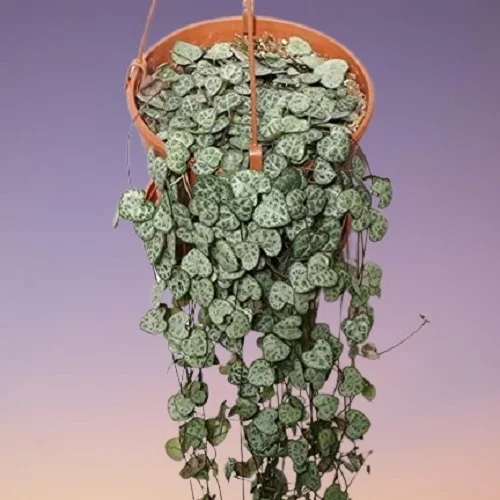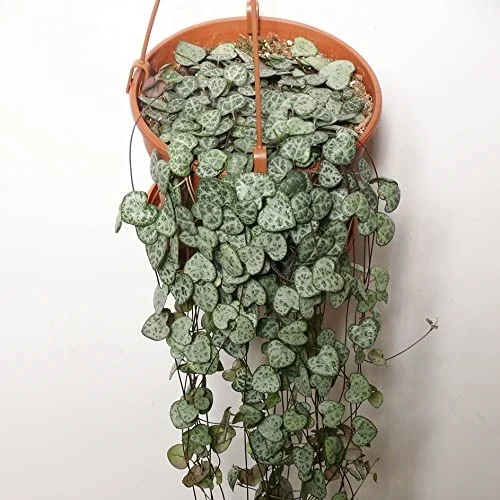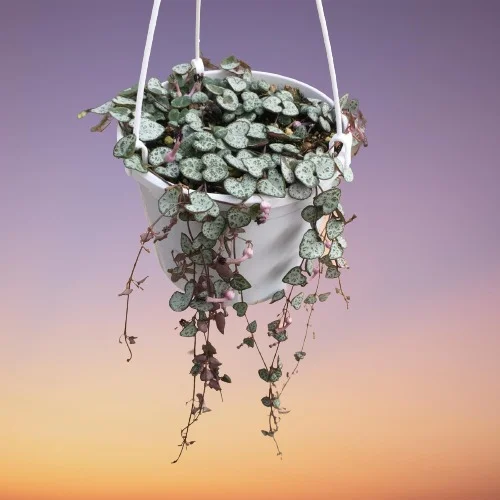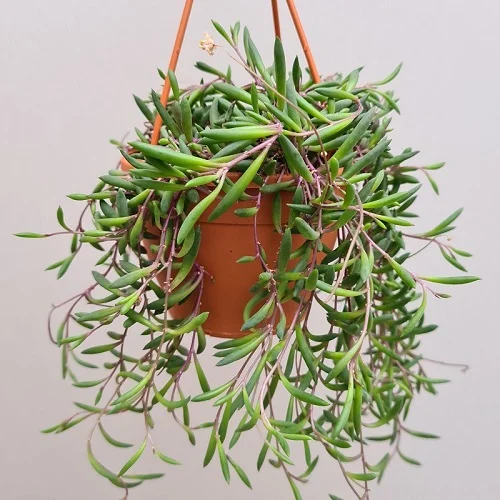11 Reasons Why String of Hearts Plant is Dropping Leaves & How to Fix Them
Some links in this post may be affiliate links
String of Hearts Plant may drop leaves due to insufficient light, inconsistent watering, soggy soil, nutrients deficiency, salts buildup, extreme temperatures, poor quality soil, pests and diseases among others.
String of Hearts Plant blossoms in bright, indirect light (filtered light), warmth of 16-250C, humidity of 50-55% and moderately moist, fertile, well-drained, succulents potting mix coupled with monthly feeding in the growing season. Learn how to grow and care for String of Hearts Plant (Ceropegia woodii).
Failure to give it these conditions may cause the the leaves to fall. Below we have outlined 11 causes of leaf drop on your String of Hearts Plant and how to fix them.

11 Causes of Leaf Drop on String of Hearts Plant & Remedies
1. Being Root-bound
A root-bound String of Hearts Plant is one whose roots have filled the pot and there is very little soil to hold water when you water the plant. As such, there is no water for the plant to take up to the leaves, therefore, the leaves loss their stiffness, they wilt and drop.
How to fix it
Check the bottom of the pot for roots growing through the drainage hole. Repot the plant into a pot one size larger than the current one. Ensure that the pot has a drainage hole and the soil is well-drained.
Use a shallow rather than deep pot as the plant has a small (shallow) root system. A clay pot is preferable as it is porous, thus allows the soil to dry out faster to prevent waterlogging of the soil. Check out these succulents pots available on Amazon.
2. Poor Quality Soil
Poor quality soil does not drain easily, therefore, it easily becomes compacted resulting in root-rot which is characterized by yellowing and leaf drop.
How to fix it
Pot your String of Hearts Plant in good quality soil that is loose, free-draining and rich in organic matter. Most Cactus and succulents mixes are ideal for this plant.
3. Pest Infestations
String of Hearts Plant is prone to spider mites, aphids and scale insects. These sap-sucking insects attack the new growth from where they suck the plant sap which may cause wilting and leaf drop.
How to fix it
Regularly inspect your String of Hearts Plant for the pests and take timely control measures.
Treat the infested plant with neem oil and an insecticidal soap as per the manufacturer's recommendations.
Keep the plant well pruned at all times by removal of yellow and dead foliage to minimize pest infestations.

4. Root-rot Disease
String of Hearts Plant is prone to root-rot disease which is prevalent in soggy soil. The disease is characterized by wilted, discolored leaves, corky swellings under the leaves and dropping leaves.
Soggy soil reduces oxygen concentration in the soil which causes the roots to die. Once the roots die, they cannot take up water and nutrients to the leaves, therefore, the leaves begin to wilt and eventually drop.
How to fix it
Slip your String of Hearts Plant out of its pot and inspect the roots.
Brown-black mushy roots indicate root-rot, trim them off and treat the healthy roots with a copper-based fungicidal solution as indicated by the manufacturer.
Disinfect the pot with the fungicidal solution or use a fresh pot to repot the plant in fresh free-draining soil.
Do not water the plant and keep it dry for some time before you can resume watering.
5. Too Little Light
Enough light is needed by the plant for making food that is required for energy and growth. Inadequate light implies that the plant cannot make enough food for energy and growth. In an attempt to save energy, it begins to drop leaves. This way, it saves the available energy for the vital functions to keep alive.
How to fix it
Cutback the bare stems to rejuvenate growth; encourage new shoots.
Move your String of Hearts Plant to a brighter spot where it will receive bright indirect light.
If you do not have sufficient lighting in your home consider investing in grow lights to supplement it.
Regularly turn the pot to ensure that the plant absorbs enough light for photosynthesis on all sides for uniform growth as well as prevent legginess.
6. Nutrients Deficiency
Underfeeding your String of Hearts Plant implies that the plant will not get enough nutrients need for growth and energy. Inadequate nutrients in the actively growing tips causes nutrients to be withdrawn from the older lower leaves which begin to yellow and drop.
How to fix it
Feed your String of Hearts Plant with a balanced, liquid fertilizer monthly in spring and summer to promote a lush growth. Do not feed the plant in fall and winter as growth is minimal at this time.
7. Salts Buildup
Accumulation of salts in the soil will cause the roots to die due to fertilizer burn. When the roots die, they cannot take up nutrients and water required for photosynthesis to make food for growth.
Lack of adequate food for growth and energy will cause the plant to drop its leaves to save energy necessary for the vital functions.
How to fix it
Be careful not to apply too much fertilizer for your String of Hearts Plant. Follow the manufacturer's instructions on the label of the plant food to avoid overfeeding.
Flush out accumulated salts from the soil regularly by running a stream of water through the soil until it comes out through the drainage holes and repeat the process several times.

8. Too Cold Water
String of Hearts Plant grows best in constantly warm conditions. Therefore, watering it with too cold water will shock the plant and it will respond with dropping its leaves.
How to fix it
Water your String of Hearts Plant with water that is at room temperature. Avoid watering it consistently with too cold water to prevent reduced growth and leaf drop.
9. Extreme Temperatures
Extreme temperatures; either too high or too low (outside the above range) will affect the normal functioning of the plant systems and thus will cause leaf drop.
Very high temperatures will cause excessive loss of water leading to wilting and leaf drop while too low temperatures will cause the plant to stop growing, drop leaves and begin to die.
How to fix it
Keep your String of Hearts Plant away from cold drafts like drafty winds, air conditioning vents, open doors and others or place it in a warmer spot.
Make sure that the plant is not near hot surfaces, hot air vents and other hot areas to prevent extremely high temperatures. Maintain an average warmth of 16-250C; usually, a room temperature that is comfortable for you is ideal for the plant.
10. Inconsistent Watering
If you underwater your String of Hearts Plant, there will be too little moisture in the soil. As such, the plant cannot take up nutrients and water needed for photosynthesis (food making process) to the leaves.
On the other hand, overwatering will result in excess water in the soil. Too much water in the soil reduces the oxygen concentration in the rootzone and this causes the roots to die.
Therefore, the plant will not get adequate food for growth and energy, thus, it drops its leaves to save energy.
How to fix it
Do not water on a schedule. Water the plant liberally in spring and summer while allowing the top 2-3 inches of soil to dry out between waterings.
Cut down on watering in fall and winter to maintain the soil slightly moist but do not allow the soil to dry out completely.
11. Soggy Soil
Soggy soil will cause the roots die which means they cannot take up water and nutrients needed for the food making process. Therefore, the plant does not make enough food for growth and energy. In a bid to save energy, it begins to drop its leaves.
How to fix it
Ensure that the pot has a drainage hole and that the soil is loose and free-draining to prevent waterlogging.
You liked it? Share on social media.
Related Content
Amazon Associates Disclosure
Homeplantsguide.com is a participant in the Amazon Services LLC Associates Program, an affiliate advertising program designed to provide a means for sites to earn advertising fees by advertising and linking to amazon.com.



